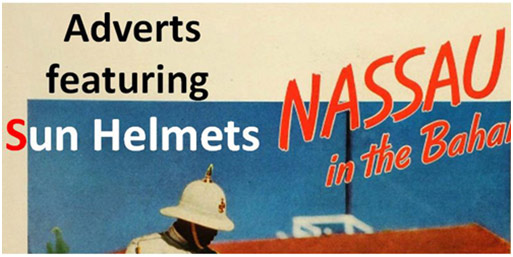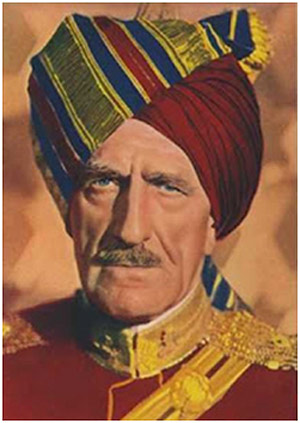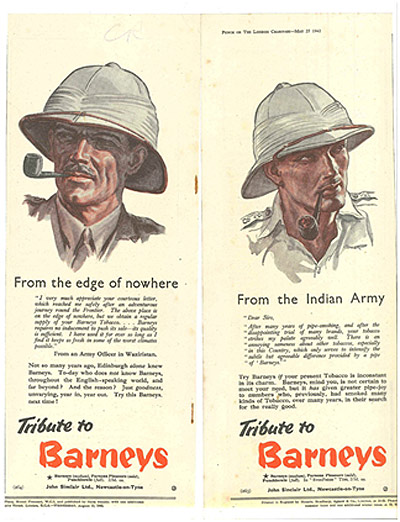Sun helmets can be found on many contemporary adverts of military outfitters or civilian hatters that manufactured such helmets for military personal. This article shows some different adverts. They do not present the sun helmet itself as a ware, but uses its significance as an icon for an exotic surrounding or to create an image of bygone circumstances. A small study in helmets and marketing methods.
“Wear a hat – It´s as healthy as it´s handsome.” An advert from an association of hat manufacturers dating from the late 1940s or early 1950s. For a collector of sun helmets, there is no question which example of the two hats shown is the most handsome. Of course, this advert was intended to aim at other potential hat wearers than helmet collectors, but in this respect it is interesting to note, that the sun helmet in this advert is attributed to be healthy – that means, regarded as indispensable in tropical countries. That view has changed since.
Aside from medical reasons, the sun helmet represents an era, when relatively small countries controlled large colonial possessions and their inhabitants. Today, an association of hat manufacturers would hardly think of advertising with a symbol of a political system of power that is no longer considered as politically correct. In the late 1960s that was still possible.
As is shown in the above example. While the helmet appears to be an American M1889 pattern helmet, it was likely meant to suggests a British foreign service type helmet to underline the fact that the habit of drinking Gin and Tonic is a time honored one. It was invented, as the text reads, about 75 years ago by a retired Colonel of the British Indian Army “vividly recalling the heat of India.” As this type of helmet was first replaced in 1898 by the Wolseley, the photographer even made the choice of a correct style of helmet if not entirely the correct pattern. That commands respect – if it was not pure coincidence.
Here, a soldier wearing a spiked Wolseley helmet can be seen as a symbol of the Bahamas. This advert from 1939 uses a photograph in colours as an eye catcher. The use of colour was not common at this time for black and white pictures or drawings were much more in use. One reason was that coloured adverts were thus limited to a few, better quality magazines, or even only a few pages inside these magazines; that is to say, the three pages inside or on the back of the cover, that was often the only part printed in colour.
A very old marketing trick is used in this series of adverts from the late 1930s. The product – in this case Dewar´s White Label Whisky – is connected to an institution of well known reputation to underline its quality and demonstrate the fact that it is globally used. Here these institutions are famous regiments of the British and Indian Armies – the British one is shown, of course, in foreign service dress. “In the far flung outposts of Empire…India, Burma, Africa… men, wise to the ways of the tropics call for long, tall DEWAR’S White Label, Medal Scotch of the World.” Further, the text mingles military awards, the sign of a successful soldier, with proofs of product quality: “Command the whisky decorated with over 60 medals for distinguished service … and be ‘At ease.’”
Here is another example of a soldier shown in a spiked Wolseley helmet, but, clearly to be seen the photograph from the Bahamas gives more justice to the reality. Note the far too long spike – that would have been more dangerous to the Empire´s enemies than the officers sword.
By the way, the drawing of the British officer from the Third Indian Cavalry reminds us of C. Aubrey Smith as senior officer in the very successful (at the time) and popular movie Lives of an Bengal Lancer. Coincidence or marketing?
Two more beautiful examples, showing just heads with pipes and helmets. Through, as the text on the advert on the left, “From the edge of nowhere”, “From an Army Officer in Waziristan” informs us: “Barneys requires no inducement to push its sales – its quality is sufficient” the manufacturer still paid for these two newspaper adverts, dated 1942. Again there are two Wolseley helmets. One is nicely detailed drawn with a leather edged brim, typical for an officer´s private purchase helmet, whereas the other example on the right “From the Indian Army” looks blancoed white. And again, the helmet indicates the global use of the product, even at the edge of nowhere in Waziristan part of the North West Frontier province of British India. Which province having for a century been a hot spot of British military operations was a comparatively peaceful area at this stage of Word War II, when fierce battles were fought in Far East and North Africa. Probably, the advert was intended to recreate an image of the more “peaceful” circumstances of small scaled wars in the “good old times” between the World Wars.
Finally, who were the people that made all these adverts? To anybody interested in the history of advertising I warmly recommend the annual volumes of “Modern Publicity,” a collection of adverts and posters first published in the 1920s. As far as I know, there was no edition for 1940, but one in 1941 – Modern Publicity in War. Here we find the self-advert of a London advertising company, C.P.V. They deal with the shortage of manpower in a humorous way, assuring their customers that they are – whatever might be the circumstances of war – still are at their service.
Though – and here again the “the edge of nowhere” is indicated by a sun helmet – “some of our directors are in strange company…”
Roland Gruschka









